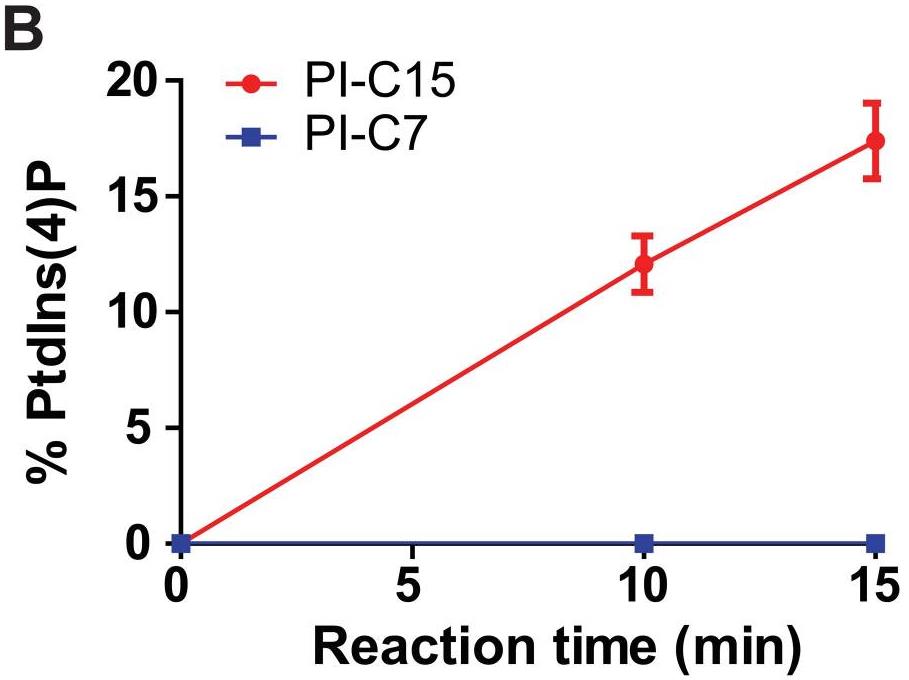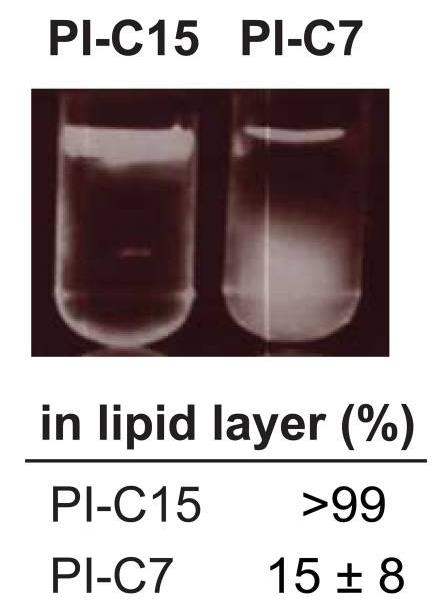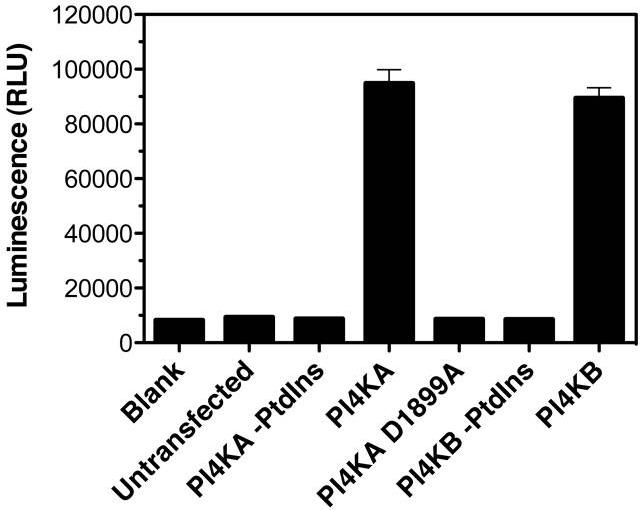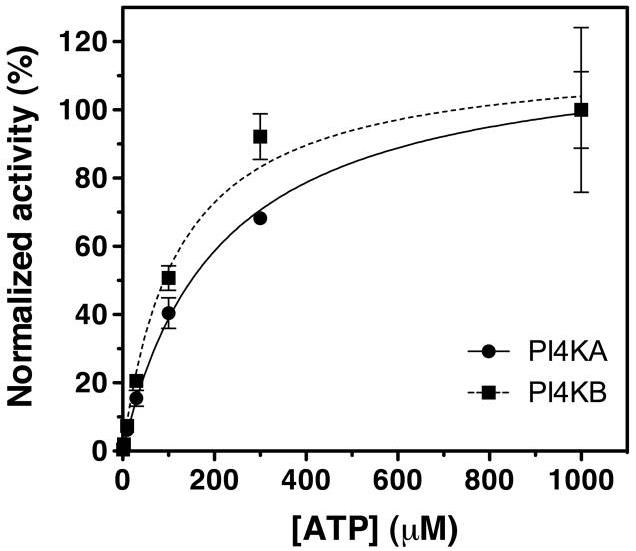Active Recombinant Human PI4K2A, GST-tagged
| Cat.No. : | PI4K2A-1450H |
| Product Overview : | Recombinant full-length human PI4K2A was co-expressed by baculovirus in Sf9 insect cells using an N-terminal GST tag. |
- Specification
- Gene Information
- Related Products
- Case Study
- Application
- Download
| Species : | Human |
| Source : | Sf9 Cells |
| Tag : | GST |
| Protein Length : | Full length |
| Description : | PI4K2A or phosphatidylinositol 4-kinase type 2 alpha is involved in the formation of phosphatidylinositolpolyphosphates (PtdInsPs) which are centrally involved in many biologic processes ranging from cell growth and organization of the actin cytoskeleton to endo- and exocytosis. PI4K2A phosphorylates PtdIns at the D-4 position which is an essential step in the biosynthesis of PtdInsPs. PI4K2A is a novel regulator of tumor growth by its action on angiogenesis and HIF-1alpha regulation. PI4K2A generates PtdIns4P-rich domains within the Golgi which regulate targeting of clathrin adaptor AP-1 complexes. PI4K2A is also required for Wnt to regulate LRP6 phosphorylation. |
| Form : | Recombinant protein stored in 50mM Tris-HCl, pH 7.5, 150mM NaCl, 10mM glutathione, 0.1mM EDTA, 0.25mM DTT, 0.1mM PMSF, 25% glycerol. |
| Bio-activity : | 95 nmol/min/mg |
| Molecular Mass : | ~79 kDa |
| Purity : | >95% |
| Applications : | Kinase Assay, Western Blot |
| Storage : | Store at –70°C. For optimal storage, aliquot target into smaller quantities after centrifugation and store at recommended temperature. Avoid freeze/thaw cycles. |
| Concentration : | 0.1μg/μl |
| Publications : |
Required hydrophobicity of fluorescent reporters for phosphatidylinositol family of lipid enzymes (2017)
A Chemical Biology Approach to Phosphoinositide Metabolic Analysis (2017)
|
| Gene Name | PI4K2A phosphatidylinositol 4-kinase type 2 alpha [ Homo sapiens ] |
| Official Symbol | PI4K2A |
| Synonyms | PI4K2A; phosphatidylinositol 4-kinase type 2 alpha; phosphatidylinositol 4-kinase type 2-alpha; DKFZP761G1923; PI4KII; PIK42A; phosphatidylinositol 4-kinase type II-alpha; phosphatidylinositol 4-kinase type II (PI4KII); RP11-548K23.6; DKFZp761G1923; |
| Gene ID | 55361 |
| mRNA Refseq | NM_018425 |
| Protein Refseq | NP_060895 |
| MIM | 609763 |
| UniProt ID | Q9BTU6 |
| Chromosome Location | 10q24 |
| Pathway | 3-phosphoinositide biosynthesis, organism-specific biosystem; 3-phosphoinositide biosynthesis, conserved biosystem; Canonical Wnt signaling pathway, organism-specific biosystem; D-myo-inositol (1,4,5)-trisphosphate biosynthesis, organism-specific biosystem; D-myo-inositol (1,4,5)-trisphosphate biosynthesis, conserved biosystem; Inositol phosphate metabolism, organism-specific biosystem; Inositol phosphate metabolism, conserved biosystem; |
| Function | 1-phosphatidylinositol 4-kinase activity; ATP binding; kinase activity; magnesium ion binding; nucleotide binding; transferase activity; |
| ◆ Recombinant Proteins | ||
| PI4K2A-12763M | Recombinant Mouse PI4K2A Protein | +Inquiry |
| PI4K2A-159H | Active Recombinant Human PI4K2A protein, GST-tagged | +Inquiry |
| PI4K2A-1450H | Active Recombinant Human PI4K2A, GST-tagged | +Inquiry |
| PI4K2A-12538Z | Recombinant Zebrafish PI4K2A | +Inquiry |
| PI4K2A-2031HFL | Recombinant Full Length Human PI4K2A Protein, C-Flag-tagged | +Inquiry |
| ◆ Cell & Tissue Lysates | ||
| PI4K2A-1350HCL | Recombinant Human PI4K2A cell lysate | +Inquiry |
Case 1: Waybright J, et al. Anal Bioanal Chem. 2017
The phosphatidylinositol (PtdIns) family of lipids plays important roles in cell differentiation, proliferation, and migration. Abnormal expression, mutation, or regulation of their metabolic enzymes has been associated with various human diseases such as cancer, diabetes, and bipolar disorder. Recently, fluorescent derivatives have increasingly been used as chemical probes to monitor either lipid localization or enzymatic activity. However, the requirements of a good probe have not been well defined, particularly modifications on the diacylglycerol side chain partly due to challenges in generating PtdIns lipids.
Here, researchers have synthesized a series of fluorescent PtdIns(4,5)P2 (PIP2) and PtdIns (PI) derivatives with various lengths of side chains and tested their capacity as substrates for PI3KIα and PI4KIIα, respectively. The reaction was initiated by the addition of purified PI4KIIα enzyme to a final concentration of 1.0 ng/μL and incubated at 37 °C. Both capillary electrophoresis and thin-layer chromatography were used to analyze enzymatic reactions. These findings are likely applicable to other lipid enzymes where the catalysis takes place at the lipid-water interface.

Fig1. Kinetic analysis of PI4K reaction with fluorescent PtdIns derivatives.

Fig2. Representative images of fluorescent PtdIns derivatives interacting with liposome.
Case 2: Tai AW, et al. Anal Biochem. 2011
Phosphatidylinositol 4-kinases (PI 4-kinases) catalyze the conversion of phosphatidylinositol to phosphatidylinositol 4-phosphate (PtdIns4P). The four known mammalian PI 4-kinases, PI4KA, PI4KB, PI4K2A, and PI4K2B have roles in intracellular lipid and protein trafficking. PI4KA and PI4KB also assist in the replication of several positive-sense RNA viruses. The identification of selective inhibitors of these kinases would be facilitated by assays suitable for high-throughput screening.
Here researchers describe a homogeneous and nonisotopic assay for PI 4-kinase activity based on the bioluminescent detection of the ADP produced by kinase reactions. By testing radiometric PI 4-kinase assay, high-throughput PI4KA assay and ADP-Glo PI 4-kinase assay of rhPI4K, they have evaluated this assay with known nonselective inhibitors of PI 4-kinases and show that it performs similar to radiometric assay formats previously described in the literature. In addition, this assay generates Z-factor values of >0.7 for PI4KA in a 384-well format, demonstrating its suitability for high-throughput screening applications.

Fig1. Characterization of purified PI4KA and PI4KB in the ADP-Glo kinase assay.

Fig2. Determination of ATP Km for PI4KA and PI4KB.
RhPI4K2A, or recombinant human phosphatidylinositol 4-kinase type 2 alpha, has several potential applications in research and drug development due to its key role in lipid signaling pathways. Some of the applications of rhPI4K2A include:
Drug discovery: RhPI4K2A can be used as a biochemical target for screening potential inhibitors in drug discovery efforts aimed at developing new therapies for various diseases, including cancer, infectious diseases, and inflammatory disorders.
Lipid signaling research: RhPI4K2A can be utilized to study lipid signaling pathways and their role in cellular processes, such as membrane trafficking, cell growth, and differentiation.
Cancer research: Dysregulation of lipid metabolism and signaling pathways, including those involving PI4K2A, has been implicated in cancer development and progression. RhPI4K2A can be used to investigate the role of this kinase in cancer biology and as a potential therapeutic target for cancer treatment.
Infectious diseases: PI4K2A has been identified as a host factor required for the replication of certain viruses, making it a potential target for antiviral drug development. RhPI4K2A can be used to screen for inhibitors that disrupt viral replication by targeting the host kinase.
Neurological disorders: PI4K2A has been implicated in neurodegenerative diseases, such as Alzheimer's disease and Parkinson's disease, due to its involvement in membrane trafficking and protein aggregation processes. RhPI4K2A can be used to study the role of this kinase in neuronal function and as a potential target for therapeutic interventions.
Overall, rhPI4K2A has diverse applications in basic research, drug discovery, and therapeutic development, seeking to enhance our understanding of lipid signaling pathways and their implications in various diseases.
Not For Human Consumption!
Inquiry
- Reviews
- Q&As
Ask a Question for All PI4K2A Products
Required fields are marked with *
My Review for All PI4K2A Products
Required fields are marked with *
Inquiry Basket


